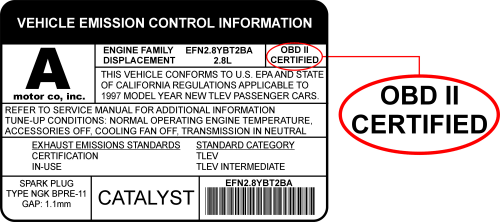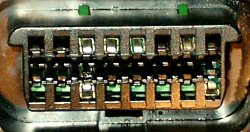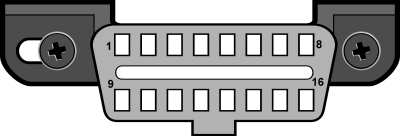How Do I Know Whether My Car is OBD-II Compliant?
This entry was posted on January 26, 2004.
OBDLink® Vehicle Compatibility Chart
**Please Note: OBD-II compatibility is not related to where the vehicle is manufactured where your vehicle was bought when new. To read the chart below, choose the country where your vehicle was sold new. If you do not see the country below, check your vehicle manual, research online, or consult with your dealership to confirm OBD-II compatibility.
**Please Note: Hybrid and Electric vehicles are low or zero emission vehicles, our scan tools may not work. Check your vehicle manual, research online, or consult with your dealership.
| Country of Sale | Model Years | Notes |
|---|---|---|
| United States | 1996 | |
| European Union (Diesel) | Full OBD-II Compliance for 2007 and onward | Limited Compliance from 2004-06 |
| European Union(Petrol) | Full OBD-II Compliance for 2002 and onward | Limited Compliance from 2001 |
| Canada | 1998 | |
| Algeria | 2014 | |
| Argentina (Domestic) | 2008 | |
| Argentina (Imports) | 2009 | |
| Australia (Diesel) | 2007 | |
| Australia (Petrol) | 2006 | |
| Bahrain | Full OBD-II Compliance for 2018 and onward | Limited Compliance from 2017-18 |
| Brazil (Petrol) | Full OBD-II Compliance for 2007 and onward | Limited Compliance from 2005-06 |
| Brazil (Diesel) | Full OBD-II Compliance for 2015 and onward | Limited Compliance from 2013-14 |
| Chile (Diesel) | 2013 | |
| Chile (Petrol) | 2014 | |
| China (Beijing - Petrol) | 2008 | |
| China (Country - Diesel) | 2011 | |
| China (Country - Petrol) | 2010 | |
| Costa Rica | Limited Compliance from 2017 onward | |
| Hong Kong | 2006 | |
| India | Full OBD-II Compliance for 2017 and onward | Limited Compliance from 2013-16 |
| Iran | 2012 | |
| Israel | 2003 | |
| Japan | Full OBD-II Compliance for 2008 and onward | Limited Compliance from 2003-07 |
| Kuwait | Full OBD-II Compliance for 2018 and onward | Limited Compliance from 2017-18 |
| Mexico | 2007 | |
| Morocco | 2010 | |
| New Zealand (Diesel) | 2007 | |
| New Zealand (Petrol) | 2006 | |
| Nigeria | 2015 | |
| Oman | Full OBD-II compliance for 2018 and onward | Limited Compliance from 2017-18 |
| Peru | 2003 | |
| Peru | 2017 | |
| Philippines | 2016 | |
| Qatar | Full OBD-II Compliance for 2018 and onward | Limited Compliance from 2017-18 |
| Russia | Full OBD-II Compliance for 2012 and onward | Limited Compliance from 2010-11 |
| Saudi Arabia | Full OBD-II Compliance for 2018 and onward | Limited Compliance from 2017-18 |
| Singapore | 2014 | |
| South Korea | Full OBD-II Compliance for 2010 and onward | Limited Compliance from 2005-09 |
| Taiwan | 2008 | |
| Thailand | 2013 | |
| Turkey | 2013 | |
| United Arab Emirates | Full OBD-II Compliance for 2018 and onward | Limited Compliance from 2017-18 |
| Vietnam | 2017 | |
| Yemen | Full OBD-II Compliance for 2018 and onward | Limited Compliance from 2017-18 |
1996 or newer model year vehicle sold in the United States
United States legislation requires all cars and light trucks model year (MY) 1996 and newer to be OBD-II compliant. More information is available on the EPA's website. Our scan tools work on all 1996 and newer cars and light trucks sold in the United States, including:
| Acura Alfa Romeo Ariel Atom Aston Martin Audi Bentley BMW Buick Cadillac Chevrolet Chrysler Citroen Daewoo |
Daihatsu Daimler Dodge Ferrari Fiat Ford Geo GMC Holden Honda Hummer Hyundai Infiniti |
Isuzu Jaguar Jeep Kia Lamborghini Lancia Land Rover Lexus Lincoln Lotus Maserati Mazda McLaren |
Mercedes Mercury MG Mini Mitsubishi Nissan Oldsmobile Opel Pagani Panoz Peugeot Plymouth Pontiac |
Porsche Regal Renault Rolls-Royce Roush Rover Saab Saleen Saturn Seat Scion Shelby Skoda |
Smart Subaru Suzuki Tesla Toyota Triumph TVR Vauxhall Volkswagen Volvo Yugo |
2001 or newer model year gasoline vehicle sold in the European Union
Commission Directive 70/220/EEC, Annex I:
8.1. Vehicles with positive-ignition engines
With effect from 1 January 2000 for new types and from 1 January 2001 for all types, vehicles of category M1, except vehicles the maximum mass of which exceeds 2500 kg, and vehicles of category N1 class I, must be fitted with an on-board diagnostic (OBD) system for emission control in accordance with Annex XI. [...]
Note that here "European Union" means countries which were members of the EU in 2000.
2004 or newer model year diesel vehicle sold in the European Union
Commission Directive 70/220/EEC, Annex I:
8.2. Vehicles with compression-ignition engines
Vehicles of category M1, except
- vehicles designed to carry more than six occupants including the driver,
- vehicles whose maximum mass exceeds 2500 kg,
from 1 January 2003 for new types and from 1 January 2004 for all types, must be fitted with an on-board diagnostic (OBD) system for emission control in accordance with Annex XI.
Note that here "European Union" means countries which were members of the EU in 2003.
Other vehicles
If your vehicle does not fall into any of the above categories, look under the hood and try to locate a label (Fig. 1) that explicitly states that the vehicle was designed to comply with OBD-II legislation.

Fig. 1 - Vehicle Emission Control Information Label
In this case, OBD-II is used as a general term and can mean any of the following:
- OBD II (California ARB)
- EOBD (European OBD)
- JOBD (Japanese OBD)
You may also consult your vehicle's owner's manual and perhaps contact your local dealer. However, be aware of the fact that many dealers do not know the difference between OBD and OBD-II.
If the vehicle is not OBD-II compliant, you cannot use a generic OBD-II scan tool such as ElmScan to obtain diagnostic information from your vehicle.
But my car has the 16-pin OBD connector, shouldn't it be OBD-II compliant?
No, not necessarily. A lot of European and Asian manufacturers equipped their vehicles with D-shaped 16-pin connectors long before they began installing OBD-II systems on those vehicles. One curious thing to note here is the fact that most non-EOBD compliant vehicles had a DLC that does not fully conform to SAE J1979. Compare figures 2 and 3, and notice the "ears" on the non-EOBD compliant Ford Focus.

Fig. 2 - Ford Escort DLC (courtesy of DigitalFriction, UK)

Fig. 3 - J1962 Vehicle Connector, Type A






